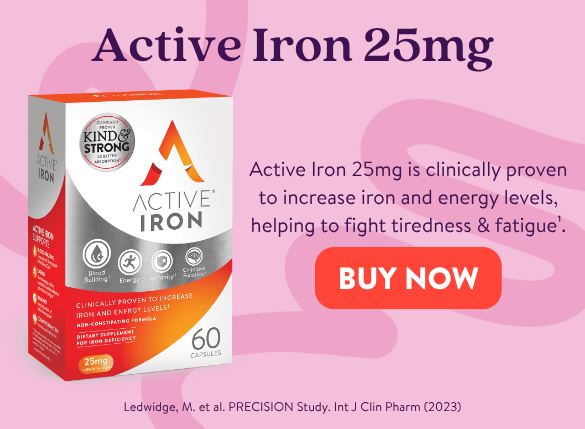Many people feel the positive effects of taking an iron supplement after 3 weeks, but it may take up to 12 weeks to feel a noticeable increase in energy levels.
Iron needs differ from person to person; as such, everyone feels the effects of iron supplementation on their own timelines. Each person will experience different levels of sensitivity, side effects, and positive improvements from iron supplements.
Here we will break down some of the most common questions when it comes to getting your iron levels up again, so you can be confident that you are getting the most out of your supplements.
How long will my Iron Supplements take to work & what does that mean?
If you were to Google “How long does it take for iron supplements to work?” you would most likely find specific answers: 2 weeks or 2 months. However, it is impossible to predict a specific period of time as to when you will start feeling the effects of your iron supplement. Many factors come into play when it comes to iron absorption, from when in the day you take iron, to how much your body needs.
It is important to bear in mind that there is a difference between how long it takes for iron to “work” and how long it takes for your body to “absorb” iron.
How long does it take for your body to Absorb Iron?
How long it takes for iron to get into your system depends largely on:
- Why were your levels low in the first place, and
- How far below the normal levels they were. The lower your current level, the longer it will take to build up a sufficient amount of iron in your system.
You should consider the following cases:
- If you need more iron because of menstruation, it will usually take a bit longer to build up, since you will continue to experience blood loss with every period.
- It is not always possible to get enough iron from your diet, and if your dietary intake of iron is insufficient, it may replenish very quickly if your supplement allows you to absorb it better.

What to Consider when Taking Iron Supplements
Your Current Diet and Nutritional Habits
An iron-rich diet can be challenging to sustain, especially if you need to build up a significant amount of iron or follow a restricted diet, such as a vegetarian diet. In this section, we will discuss foods that increase and decrease iron absorption.
Foods that Decrease Iron Absorption
Some foods and nutrients are natural iron inhibitors – they diminish the absorption of iron and make it difficult for you to reach optimal iron levels. These foods/nutrients include:
- Phytic acid (often found in grains and legumes)
- Tannins
- Polyphenols (found in tea)
- Milk
- Caffeine
- Some of the proteins found in soybeans
(And, considering many people’s days start with a cup of coffee or a bowl of milk and cereal, we can quickly begin to see why iron absorption is a challenge.)
Foods that Increase Iron Absorption
On the bright side, there are foods known to increase your iron absorption, and they are often recommended to be taken alongside iron supplements. These include:
- Citrus items and citric acid – lemons, lemonade, oranges, orange juice
- Vitamin C
- Vitamin A and beta-carotene
How Quickly Do Iron Supplements Work?
It can take anywhere from 3 to 12 weeks to feel the benefits of taking an iron supplement.
In all cases, if you suspect you need more iron, the best approach is to talk to a healthcare professional. Your healthcare professional can guide you through the next steps, while helping you figure out the reasons you might not be feeling well and if iron is indeed a factor in your feeling tired or fatigued. From there, they can advise whether iron supplements will be of benefit to you.
Active Iron is clinically proven to increase iron and energy levels in six weeks, but many report seeing an increase in their energy levels after three weeks.
Iron absorption FAQs
How quickly do iron supplements work?
Hemoglobin blood levels generally increase after 2 to 4 weeks of supplementation. Symptoms like fatigue, and headache should start to improve during this time. It typically requires around three months for iron stores (measured by ferritin levels) to reach a normal level.
How quickly do iron supplements work?
Hemoglobin blood levels generally increase after 2 to 4 weeks of supplementation. Symptoms like fatigue, and headache should start to improve during this time. It typically requires around three months for iron stores (measured by ferritin levels) to reach a normal level.
How long should I take iron supplements for?
Iron supplements should be taken for at least 6 months and up to 12 months. The best way to ensure adequate absorption is to take them on an empty stomach or allow 2 to 3 hours between meals as certain food, drink and medicines may inhibit iron absorption.
How long does it take to get iron levels up?
Active Iron is clinically proven to increase iron levels by 94% in 6 weeks, but many start to feel the benefits earlier than that.
How long does it take for iron levels to drop?
Your body uses about 500 mg of iron to make about 2g/dl of haemoglobin, which is a protein in your red blood cells that carries oxygen. We require extra iron to create energy and for our body to function correctly.
When we stop taking iron, the body uses internal reserves of iron. The drop in iron levels will depend on our diet and way of life. For example, if you like doing endurance sports your iron levels could fall quicker. As iron levels fall below the standard range, you may notice fatigue, headaches, cold hands and feet.
How long does it take to raise iron levels with food?
This is something that is quite complicated to measure, considering everyone has different health needs. There are two different forms of iron in the diet: Heme and Non-Heme Iron. Haem Iron is much easier absorbed by the body and so is the optimum source for raising iron levels. Examples of Haem Iron rich foods are: red meat, offal and poultry. Non-Haem Iron foods include fortified breakfast cereals, and dark green leafy vegetables such as broccoli and cabbage. However, it may be difficult to raise iron levels with food alone, particularly for people with restricted diets such as vegetarians and vegans.
How do you know if iron tablets are working?
Everybody responds to iron supplements differently but most people can expect to see an improved ability to concentrate, a healthier immune system resulting in fewer colds, and a feeling that you have more energy.
These signs may not be very pronounced so it’s still important to review how much iron you consume through your diet and how well your iron pills are being absorbed.
If you have any concerns that your iron pills are not working, you should consult your doctor.
Enjoy The Benefits Of Active Iron
If you want to reap all the benefits of optimal iron intake, you need to ensure you are absorbing iron well and getting enough iron in your diet. If your diet isn’t giving you enough iron, and you choose to supplement your iron intake, you will want to choose a supplement that provides optimum absorption and is kind to your stomach.
Active Iron supplements are designed with a unique formula that targets the right place for absorption, the DMT-1. This helps reduce oxidation, thus protecting the gut from inflammation. As a result, Active Iron is highly absorbed compared to other iron supplements¹, making it gentle on the stomach, and clinical results have shown that it increases iron levels by 94%².
So, if you want to know how long it will take for your iron supplements to work, remember this guide and start taking Active Iron today.
¹Wang et al. 2017, Acta Haematologica, ²Ledwidge, M. et al. PRECISION Study. Int J Clin Pharm (2023) https://doi.org/10.1007/s11096-023-01640-7

